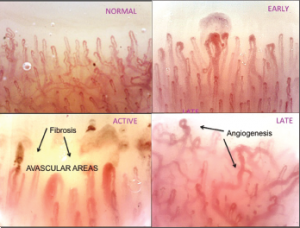When choosing which type of equipment to purchase, rheumatologists should also think about whether image storing is important for their use. Dr. Herrick notes, “Most commercially available videocapillaroscopy systems allow for easy storage of images, which can then be uploaded onto the patient’s electronic record.” Digitally stored images can also easily be sent via the Internet for telediagnosis and teleconsultation.
Training

The three validated capillaroscopic qualitative patterns (early, active and late) that characterize the progressive damage of the microvasculature in systemic sclerosis. The concomitant count of the capillaries (within 1 linear mm inside the picture) allows us to quantify and score the progression of the disease. Prediction of clinical complications and prognostic evaluations are supported by the changes in capillary number.
Attaining proficiency in assessing nailfold capillaries via videocapillaroscopy does take more time than some other methods.5 However, Dr. Herrick notes, “It does not take long to become reasonably competent in acquiring and analyzing images, and after a one- to two-day training course, most clinicians will feel reasonably confident in any of the techniques. As with most methodologies, to stay confident and competent, it is necessary to use capillaroscopy regularly.”
Since 2004, EULAR has offered a three-day training course in capillaroscopy every other year. The next scheduled course will be September 2018 in Genova, Italy. For the past six years, the ACR/ARHP Annual Meeting has also offered a workshop on practical capillaroscopy. Dr. Herrick notes that other countries and regions are also running training courses. The Atlas of Capillaroscopy in Rheumatic Diseases is another helpful training tool.
Dr. Cutolo says nailfold capillaroscopy has been slower to be adopted by U.S. practitioners, perhaps partly because it has only more recently begun to be discussed at clinical conferences there. Partly to address this need, Dr. Cutolo and colleagues developed an educational curriculum to teach rheumatology fellows the skills needed to assess nailfold capillaries at the Hospital for Special Surgery in New York. Specifically, the study aimed to teach rheumatology fellows how to use dermoscopy as a tool to diagnose systemic sclerosis while in the clinic. In a one-day course, residents increased their skills in recognizing capillaroscopy abnormalities. Currently, most American rheumatology fellowship programs do not have standardized training in nailfold capillaroscopy.17
Promising Research Avenues
In future research, Dr. Herrick believes we will learn more about how capillaroscopy can help predict disease course in SSc. Other promising research is studying capillaroscopy to assess treatment response and disease process. She explains, “With this aim in mind, at the University of Manchester, we are researching automated analysis of capillaroscopy images using a machine learning approach.”

